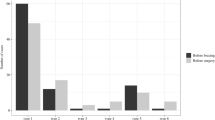Abstract
Current complication rates for adolescent scoliosis surgery necessitate the development of better surgical planning tools to improve outcomes. Here we present our approach to developing finite element models of the thoracolumbar spine for deformity surgery simulation, with patient-specific model anatomy based on low-dose pre-operative computed tomography scans. In a first step towards defining patient-specific tissue properties, an initial ‘benchmark’ set of properties were used to simulate a clinically performed pre-operative spinal flexibility assessment, the fulcrum bending radiograph. Clinical data for ten patients were compared with the simulated results for this assessment and in cases where these data differed by more than 10%, soft tissue properties for the costo-vertebral joint (CVJt) were altered to achieve better agreement. Results from these analyses showed that changing the CVJt stiffness resulted in acceptable agreement between clinical and simulated flexibility in two of the six cases. In light of these results and those of our previous studies in this area, it is suggested that spinal flexibility in the fulcrum bending test is not governed by any single soft tissue structure acting in isolation. More detailed biomechanical characterisation of the fulcrum bending test is required to provide better data for determination of patient-specific soft tissue properties.










Similar content being viewed by others
References
Asher M, Burton DC (2006) Adolescent idiopathic scoliosis: natural history and long term treatment effects. Scoliosis 1:2
Aubin CE, Petit Y, Stokes IA et al (2003) Biomechanical modeling of posterior instrumentation of the scoliotic spine. Comput Methods Biomech Biomed Eng 6:27–32
Bjornstrup J (1996) Estimation of human body segment parameters—statistical analysis of results from prior investigations. Technical report ISSN 0906-6233, Laboratory of Image Analysis, Institute of Electronic Systems, Aalborg University, Denmark
Brasiliense LBC, Lazaro BCR, Reyes PM et al (2011) Biomechanical contribution of the rib cage to thoracic stability. Spine 36(26):E1686–E1693
Cann CE (1988) Quantitative ct for determination of bone mineral density: a review. Radiology 166:509–522
Chazal J, Tanguy A, Bourges M et al (1985) Biomechanical properties of spinal ligaments and a histological study of the supraspinal ligament in traction. J Biomech 18:167–176
Cheung KM, Luk KD (1997) Prediction of correction of scoliosis with use of the fulcrum bending radiograph. J Bone Jt Surg Am 79:1144–1150
Cobb RJ (1948) Outline for study of scoliosis. In: American academy of orthopaedic surgeons, instructional course lectures. CV Mosby, St Louis, pp 261–275
Cunningham H, Little JP, Pearcy MJ et al (2007) The effect of soft tissue properties on overall biomechanical response of a human lumbar motion segment: a preliminary finite element study. In: Brebbia CA (ed) Modelling in medicine and biology VII, with transactions on biomedicine and health. WIT Press, Southampton, pp 93–102
Dumas R, Aissaoui R, Mitton D et al (2005) Personalized body segment parameters from biplanar low-dose radiography. IEEE Trans Biomed Eng 52:1756–1763
Erdmann WS (1997) Geometric and inertial data of the trunk in adult males. J Biomech 30:679–688
Hawes MC, O’Brien JP (2008) A century of spine surgery: what can patients expect? Disabil Rehabil 30:808–817
Kumaresan S, Yoganandan N, Pintar FA et al (1999) Finite element modeling of the cervical spine: role of intervertebral disc under axial and eccentric loads. Med Eng Phys 21:689–700
Lemosse D, Le Rue O, Diop A et al (1998) Characterization of the mechanical behaviour parameters of the costo-vertebral joint. Eur Spine J 7:16–23
Little JP (2004) Finite element modelling of anular lesions in the lumbar intervertebral disc. Queensland University of Technology, Brisbane
Little JP, Adam C (2011) Patient-specific computational biomechanics for simulating adolescent scoliosis surgery: predicted vs clinical correction for a preliminary series of six patients. Int J Numer Methods Biomed Eng 27:347–356
Little JP, Adam CJ (2009) The effect of soft tissue properties on spinal flexibility in scoliosis: biomechanical simulation of fulcrum bending. Spine 34:E76–E82
Little JP, Adam CJ (2011) Effects of surgical joint destabilization on load sharing between ligamentous structures in the thoracic spine: a finite element investigation. Clin Biomech 26(9):895–903
Little JP, de Visser H, Pearcy MJ et al (2008) Are coupled rotations in the lumbar spine largely due to the osseo-ligamentous anatomy?—a modeling study. Comput Methods Biomech Biomed Eng 11:95–103
Little JP, Pearcy MJ, Pettet GJ (2007) Parametric equations to represent the profile of the human intervertebral disc in the transverse plane. Med Biol Eng Comput 45:939–945
Lu YM, Hutton WC, Gharpuray VM (1996) Do bending, twisting, and diurnal fluid changes in the disc affect the propensity to prolapse? A viscoelastic finite element model. Spine 21:2570–2579
Nachemson A (1960) Lumbar intradiscal pressure: experimental studies on post-mortem material. Acta Orthop Scand 43
Nolte LP, Panjabi M, Oxland T (1990) Biomechanical properties of lumbar spinal ligaments. In: Heimke G, Soltesz U, Lee AJC (eds) Clinical implant materials. Elsevier Science Publishing, Amsterdam, pp 663–668
Oda I, Abumi K, Cunningham BW et al (2002) An in vitro human cadaveric study investigating the biomechanical properties of the thoracic spine. Spine 27:E64–E70
Oda I, Abumi K, Lu D et al (1996) Biomechanical role of the posterior elements, costovertebral joints, and rib cage in the stability of the thoracic spine. Spine 21:1423–1429
Vrtovec T, Pernus F, Likar B (2009) A review of methods for quantitative evaluation of spinal curvature. Eur Spine J 18:593–607
Watkins RT, Watkins R 3rd, Williams L et al (2005) Stability provided by the sternum and rib cage in the thoracic spine. Spine 30:1283–1286
Weinstein S, Dolan L, Cheng J et al (2008) Adolescent idiopathic scoliosis. Lancet 371:1527–1537
Weiss HR, Goodall D (2008) Rate of complications in scoliosis surgery—a systematic review of the pub med literature. Scoliosis 3:9
Author information
Authors and Affiliations
Corresponding author
Rights and permissions
About this article
Cite this article
Little, J.P., Adam, C. Towards determining soft tissue properties for modelling spine surgery: current progress and challenges. Med Biol Eng Comput 50, 199–209 (2012). https://doi.org/10.1007/s11517-011-0848-6
Received:
Accepted:
Published:
Issue Date:
DOI: https://doi.org/10.1007/s11517-011-0848-6




